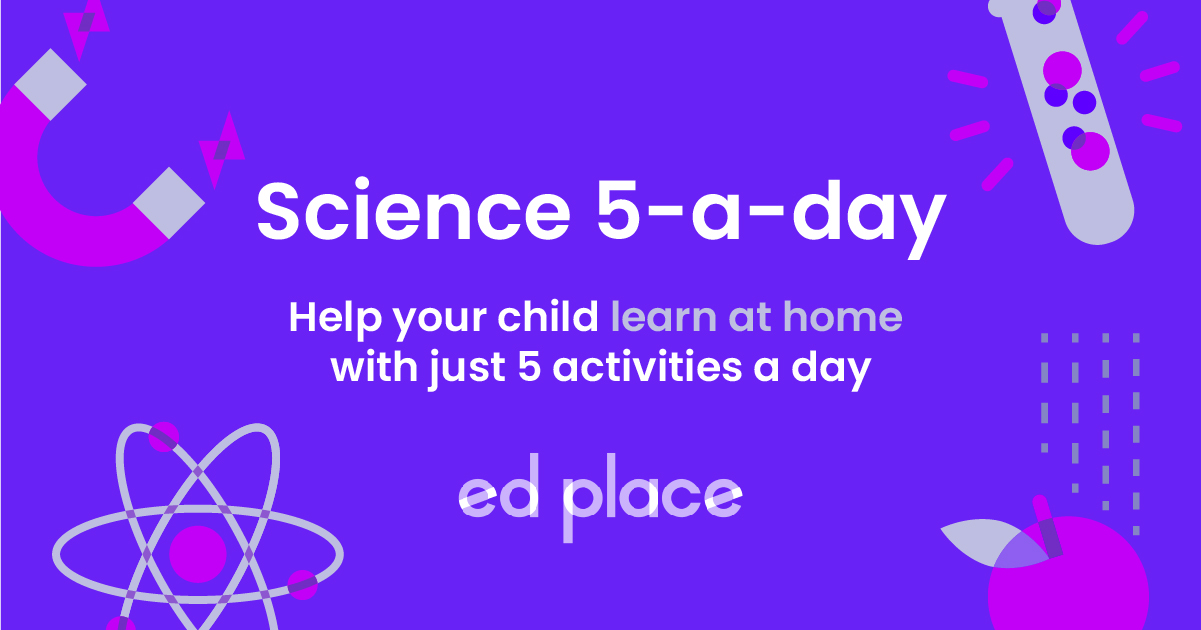
EdPlace's Year 4 Home Learning Science Lesson: Water Cycle
Looking for short lessons to keep your child engaged and learning? Our experienced team of teachers have created English, maths and science lessons for the home, so your child can learn no matter where they are. And, as all activities are self-marked, you really can encourage your child to be an independent learner.
Get them started on the lesson below and then jump into our teacher-created activities to practice what they've learnt. We've recommended five to ensure they feel secure in their knowledge - 5-a-day helps keeps the learning loss at bay (or so we think!).
Are they keen to start practising straight away? Head to the bottom of the page to find the activities.
Now...onto the lesson!
So, let's see if you need to purify your current thinking...
It’s said that we human beings are about 70% water, so clearly it’s vital stuff. But how does planet Earth ensure that there’s always liquid water available? That’s down to the water cycle and it’s one of those areas that can be a tad tricky and it’s likely that your young scientist may be a little cloudy on the issue.
Rest-assured that the team at EdPlace have got you covered! So let’s vaporise the mists of misunderstanding and rain down information in rivers of clarity! It’s time to sort out the muddle of condensation, bodies of water, precipitation and evaporation and restore the purity of down-to-earth understanding!
We're sure if you do, your child will be able to:
1) Understand how the water cycle operates and why the various factors in it cause it to happen
2) Apply this understanding
3) Explain the different parts of sound covered in this lesson back to you.
Step 1: Pedalling our knowledge!
When you turn the tap on, you expect water to come out. Of course, we’re lucky in the UK to have easy access to fresh, clean water as there are many countries across the world which are not that fortunate. But, have you ever thought about how it is that something we take for granted is always there? Maybe, as climate change accelerates, that situation is going to change? It’s certainly going to change for some parts of the world. So, how is it that water is always available to us? Let’s have a look...
First off, one of the areas that your young scientist may struggle with is understanding the words that are associated with the water cycle. Let’s list them here, and then we’ll get stuck into what they’re about and, hopefully, help them make a good deal more sense.
Evaporation – this is the process by which liquids are changed into gases (remember the ‘states of matter’ topic?). It always involves warmth or heat to change the liquid into a gas.
Condensation – this is the exact opposite of evaporation; in other words, gas is cooled down until it changes back into a liquid.
Precipitation – this simply means stuff falling from the skies (and I don’t mean fish!) - anything like rain, sleet, snow, hail, etc. - that’s precipitation.
Clouds – there cannot be precipitation without clouds; these are made of water vapour and, when conditions are right, rain and so on falls from them.
Bodies of water – this simply refers to large areas of water like seas and oceans, lakes and so on.
Whenever that confusion arises, just nip back here to remind yourself of what these words mean. Remember that scientific learning is not about stuffing facts in – it’s about understanding processes, how things work, and then applying that understanding.
So how does all this fit into the water cycle?
Let’s have a closer look……….
Step 2: Is a lot of energy needed to keep recycling water?
Actually, that’s an interesting question and it’s an integral part of the whole water cycle.
So, we’ve established that life on Earth needs water as organisms (like us) contain a lot of water. That’s one of the reasons that deserts (where there’s very little water) contain much less life than anywhere else. Conversely, tropical rainforests (the clue’s in the name!) are teeming with life!
So, for life to continue to thrive, the water cycle is absolutely vital. One of the best ways to get into this is to take it from a recycling perspective. I mean, there’s you, putting out your recycling, on a regular basis, to be collected and taken away for … recycling. Take those aluminium foil containers you had that Indian takeaway in – once washed and cleaned, they are taken away to be turned into drinks cans, Landrovers, aluminium foil, all sorts. But the great thing is that it saves massive amounts of energy: to turn that aluminium into, say, a drinks can, saves 95% of the energy it would take to dig new aluminium out of the ground!
So, recycling saves energy and it saves the Earth’s resources by reusing them. Water is just such a resource and, since life on the planet depends on it, it mustn’t run out! That means there has to be a natural system for recycling it – and that’s where the water cycle comes in: turning ‘used’ water into freshwater once again.
OK, let’s break this down a bit:
1. Water needs recycling, and recycling needs energy. What’s the Earth’s energy source?
The Sun!
2. So, we need to send water from, say, the sea to the land – how’s that going to happen?
Evaporation! The warmth of the sun makes water in the sea evaporate into water vapour in the air.
3. Right, but life on the planet cannot drink water vapour.
So, it has to be condensed back into liquid water. That happens as the vapour rises: it cools back down and forms tiny droplets (clouds) which gather into larger droplets and fall back to earth (precipitation).
4. Now it soaks into the earth, forms streams, rivers, peat bogs and so on. Now it’s available for organisms to use and it continues flowing back to the sea.
Do you feel a rough drawing coming on? Why not pause here and get your young scientist to sketch out, using arrows and words, how water evaporates, condenses and falls back to earth? Then we’ll look at the nitty-gritty of the process.
Step 3: Are you ready to complete the cycle?
So, have you got the idea that for there to be fresh water on land it has to be recycled from large bodies of water, like the oceans? How did that drawing go? Guess it’ll be something along these lines?

See those arrows going up from the sea? What’s going on there?
The warmth of the sun is evaporating the water, turning it into water vapour.
What happens as it rises?
It cools down and condenses to form clouds of tiny water droplets.
How does the water in the clouds reach the land?
Winds blow the clouds to move them around the Earth. Over land, when the water in them turns into rain, hail and so on, it falls as precipitation on the land.
What happens to the water on the land?
It soaks into the soil and it gathers into streams and rivers and it can be used by all living organisms living on the land.
How does it get to the sea?
The water in the rivers continues flowing across the land until it reaches the sea.
Does that make sense? Just to be sure, go over it again, adding anything else to your drawing that you want to.
Well, does your young scientist feel they’ve got a better handle on what the water cycle is about and how it works? Ready for some questions to see?
Let’s check it out...
Step 4: Putting it into practice...
Here’s the water cycle but we’ve jumbled up the main different points in the cycle, so that it doesn’t make sense. Can you get them into a sensible order?
1. Clouds form.
2. Water flows to the sea in rivers.
3. Water soaks into the soil.
4. Water vapour cools as it rises.
5. Water collects into streams and rivers which flow across the land.
6. The warmth of the Sun evaporates water from the surface of bodies of water.
7. Precipitation falls on to the surface of the planet.
8. Water vapour rises from oceans and other bodies of water.
9. Water droplets in clouds collect into larger droplets.
Step 5 - Exploring the water cycle further...
Now, you’ve covered this together why not put this to the test and assign your child the following four activities in this order:
All activities are created by teachers and automatically marked. Plus, with an EdPlace subscription, we can automatically progress your child at a level tailored to their needs. Sending you progress reports along the way so you can track and measure progress, together - brilliant!
Activity 1 - The Water Cycle 1
Activity 4 - The Water Cycle 2
Answers
Now, of course, it’s a cycle, so there’s no specific starting point. However, the cycle goes in this order, so you can dive in wherever, but continue in this order:
6 – 8 – 4 – 1 – 9 – 7 – 3 – 5 – 2
If your young scientist is in any doubt, re-draw the cycle adding these numbers at the appropriate point.
Keep going! Looking for more activities, different subjects or year groups?
Click the button below to view the EdPlace English, maths, science and 11+ activity library
All English, maths and science from Year 1 - GCSE







